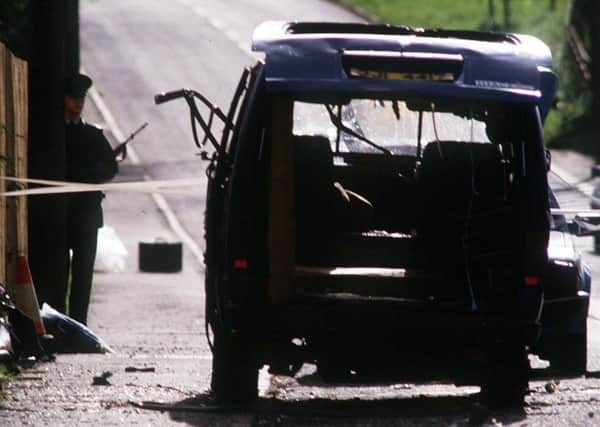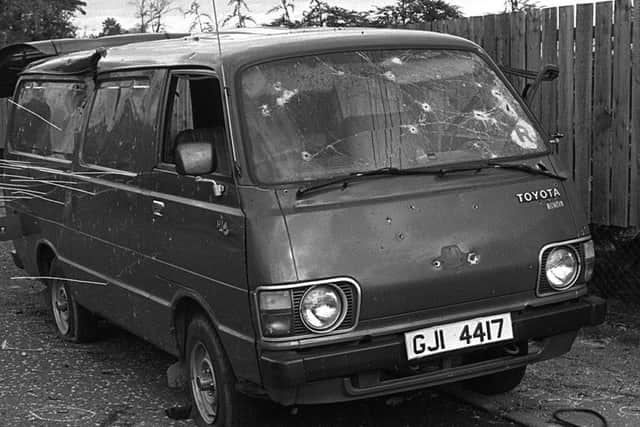Loughgall: How compelling intelligence helped foil IRA gang


The coincidence and timing could not have been any worse. The SAS killed Anthony and seriously injured Oliver, the latter receiving emergency medical treatment from either the SAS or E4 HMSU.
Within minutes an ambulance was called and fronted by a police escort to the hospital. Oliver survived.
Advertisement
Hide AdAdvertisement
Hide AdThe SAS ‘cut-offs’ broke cover and exposed themselves to great danger in order to protect three women in a car that the attackers had fired at, moving it away from harm.


Another car driven by a woman containing a young child was dealt with similarly and a third involved protecting a man who had run from his car.
In total, eight innocent civilians in four separate vehicles were caught up in the shooting.
Even with the benefit of hindsight the opinion of the E4 HMSU officer is that the speed and scale of the assault meant that the area could not have been cordoned off any better.
Advertisement
Hide AdAdvertisement
Hide AdAll three police were hospitalised. None returned fire. No attackers escaped. The incident lasted between five and ten minutes.


Special Branch assessed that E4 HMSU could not counter this type of unit without dramatically increasing the risk to officers and the public.
The heaviest calibre weapon E4 had was a .223 calibre Heckler and Koch 33 rifle, which was less powerful than the 7.62 NATO calibre weapons used by the terrorists at Loughgall or the 50 Calibre weapons and RPGs available to cross-border IRA brigades.
In contrast the SAS had superior firepower to East Tyrone/Monaghan IRA, chiefly in two general purpose machine guns (GPMGs) of 7.62 NATO calibre.
Advertisement
Hide AdAdvertisement
Hide AdThe GPMG is a belt-fed weapon that fires 750 rounds per minute and is accurate up to distances of just over a mile. Both were sited in a wooded area overlooking the station approximately 300-400 yards away.
Precise short bursts of three to four rounds fired from each were the decisive factor. Over 1,000 rounds were fired by the SAS, the majority from the GPMGs, which left both barrels smoking hot.
The SAS also had the latest Heckler and Koch (7.62 NATO calibre) rifles, which were very powerful.
Relevant to examining the Loughgall incident is how eight terrorists of the same brigade led by Lynagh attacked the home in Tynan of 86-year old Sir Norman Stronge and his son James (a part-time police reservist) with machine guns and grenades in 1981.
Advertisement
Hide AdAdvertisement
Hide AdBoth victims were shot in the head at close range and their family home burnt down. Hearing the explosions local police responded but were ambushed. A short gun battle ensued in which the police came a poor second.
The security response on the southern side was suspiciously slow and allowed the terrorists to escape back across the border, vindicating Lynagh’s decision to shoot it out and adding to his belief that he and his men were invincible.
It was a view many police shared, especially when considering the murders perpetrated by East Tyrone/Monaghan IRA in the following years without any sign of them being stopped.
There was nothing in law enforcement anywhere in the world capable of tackling seasoned killers in heavily armed gangs like the IRA’s cross-border brigades.
Advertisement
Hide AdAdvertisement
Hide AdWhile the intelligence for Loughgall was compelling it was not definitive. The assessment of it was quite brilliant.
For such a plan, the Chief Constable authorises it based on a briefing by the Head of Special Branch (HSB), an assistant chief constable (ACC) at HQ, and requests resources from the army.
Senior uniform and CID officers, the Permanent Under Secretary of State in the NIO and Director and Co-ordinator of Intelligence (MI5) are informed.
The latter two brief the Northern Ireland Secretary of State who briefs the prime minister.
Advertisement
Hide AdAdvertisement
Hide AdIt is a dynamic and fast ground-up process. There is no political interference. The police are very much in charge. A consortium of expert opinion, having considered the tactical menu, assessed the SAS was the best tactical option and the only viable response available in the circumstances.
Overt tactical options like pre-emptive arrests aimed to prevent, or covert tactical options like surveillance aimed at gathering more intelligence, were unsuited at Loughgall.